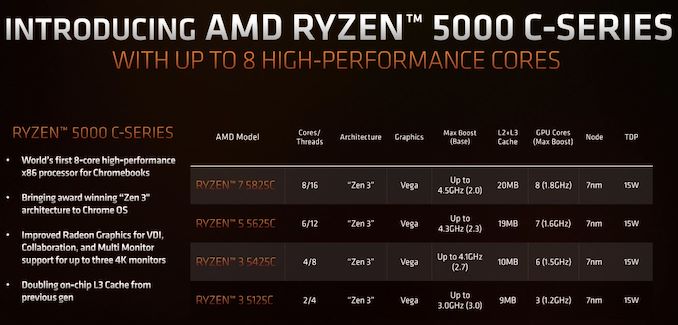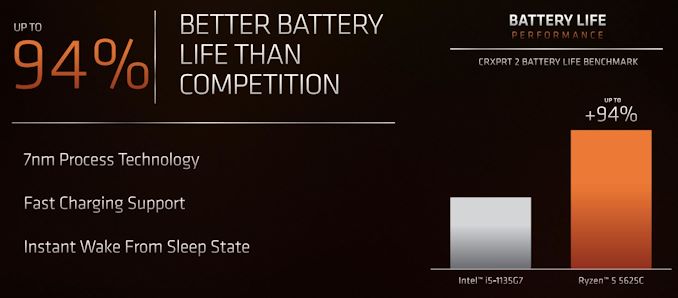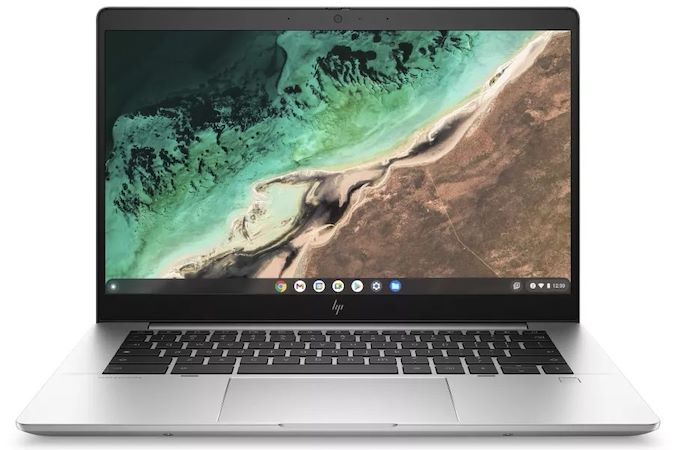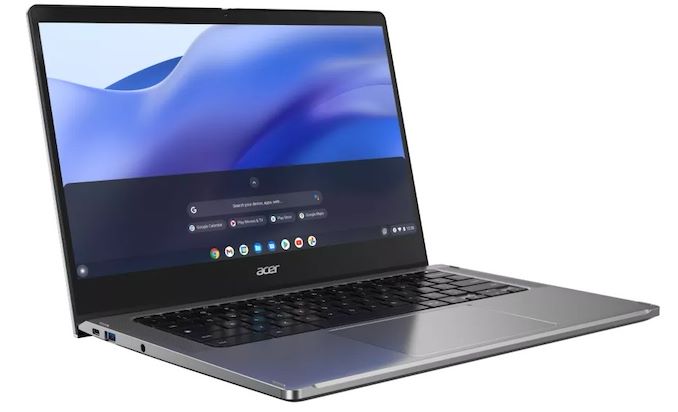AMD Announces Ryzen 5000 C-Series For High-End Chromebooks
by Gavin Bonshor on May 5, 2022 4:30 PM EST- Posted in
- CPUs
- Acer
- AMD
- HP
- Chromebook
- Ryzen Mobile
- Ryzen C-Series
- Ryzen 5000
- Zen3

In September 2020, AMD released its Ryzen 3000 C-series for Chromebooks, a line up of budget-priced chips based on the 12nm Picasso (Ryzen+) architecture that featured up to 4 cores and 8 threads and up to 11 Radeon Vega compute units. Nearly two years on and AMD has just announced four new Ryzen 5000 C-series SKUs designed to bring the performance benefits of its Cezanne (Zen 3) architecture to the Chromebook space.
The four new Ryzen 5000 C-series processors range from 8C/16T to 2C/4T, all with a 15 W TDP and designed to improve productivity and battery life over existing Ryzen 3000 C-series processors and Intel's 11th Gen Tiger Lake chips.
Aimed at the premium area of the Chromebook market, the new AMD Ryzen 5000 C-series looks to offer OEMs and users premium options for the latest generation of Chromebooks with some higher-end features such as fast charging and Wi-Fi 6E networking capability.
| AMD Ryzen 5000 C-Series For Chromebooks (Zen 3) | ||||||||
| AnandTech | Core/ Thread |
Base Freq |
1T Freq |
L2/L3 Cache |
iGPU | iGPU Freq |
TDP | |
| Ryzen 7 5825C | 8 | 16 | 2000 | 4500 | 20 MB | Vega 8 | Up to 1.8 GHz | 15 W |
| Ryzen 5 5625C | 6 | 12 | 2300 | 4300 | 19 MB | Vega 7 | Up to 1.6 GHz | 15 W |
| Ryzen 3 5425C | 4 | 8 | 2700 | 4100 | 10 MB | Vega 6 | Up to 1.5 GHz | 15 W |
| Ryzen 3 5125C | 2 | 4 | 3000 | 3000 | 9 MB | Vega 3 | Up to 1.2 GHz | 15 W |
Looking at the specifications of the Ryzen 5000 C-series line-up, the top model is the Ryzen 7 5825C with an impressive 8 cores and 16 threads which is double that of the previous top-tier Chromebook Ryzen processor, the AMD Ryzen 7 3700C. It has a base core frequency of 2 GHz, with a boost core clock of up to 4.5 GHz on a single core, which is bolstered by its Radeon Vega 8 integrated graphics with a maximum boost frequency of up to 1.8 GHz.
The second model in the new line-up is the Ryzen 5 5625C, which has 6 cores, 12 threads, and integrated Radeon Vega 7 graphics with a maximum boost frequency of up to 1.6 GHz. The 6 cores feature a base frequency of 2.3 GHz, while one of these cores can boost up to 4.3 GHz for applications that demand additional performance.
Focusing on the two entry-level models in the line-up, the Ryzen 3 5425C benefits from 4 cores and 8 threads with a base frequency of 2.7 GHz, with a boost frequency on one core of up to 4.1 GHz, as well as AMD's Radeon Vega 6 graphics that can boost up to 1.5 GHz. The Ryzen 3 5125C is the lowest in the new C-series stack with just 2 cores and 4 threads, has a consistent core clock speed of 3 GHz, and has 3 Vega graphics compute cores with a maximum boost frequency of up to 1.2 GHz.
As we go from top to bottom, each model in the line-up increases in base core frequency, while the boost clocks bar the Ryzen 3 5125C, which has a set core clock speed of 3 GHz, experience a drop in frequency. All the Ryzen 5000 C-series models feature a 15 W TDP envelope, so core frequency on both the Zen 3 cores and the Radeon Vega cores will depend on the application, task, or game being used to optimize the relative power envelope to fit within the 15 W TDP threshold.
While we don't typically concern ourselves with vendor-given performance data, perhaps the most impressive of AMD's claims is battery life. AMD is claiming that the Ryzen 5 5625C has up to improve battery life by 94% when directly compared to Intel's Core i5-1135G7 processor, which, if true, is very impressive. One of the main benefits of the Chromebook series is usability, and having an improved battery life can increase overall productivity and lifespan when using it while traveling between charges.
So far, AMD has announced two of its partners already on board with its Ryzen 5000 C-series for Chromebooks, including HP and Acer. Both are launching new models due later on in the year, but AMD highlighted two new models:
HP Elite C645 G2 Chromebook
The first of the new Chromebooks to feature AMD's Ryzen 7 5825C processor is the HP Elite C645 G2. HP is expected to offer multiple display options, including various configurations of its 14" 1080p touchscreen panel and plenty of impressive features. These include support for up to 16 GB of LPDDR4X memory with up to 512 GB of PCIe storage. Other features include the latest Wi-Fi 6E wireless and BT 5.2 connectivity and an optional 4G LTE version. The HP Elite C645 will also have a 5 MP integrated webcam, a SmartCard terminal for a CAD-capable keyboard, and an SEC fingerprint sensor for added security.
The HP Elite C645 G2 Chromebook is expected to hit retail shelves in Q2 2022, with pricing currently unknown.
Acer Chromebook Spin 514
The second of the new Ryzen 5000 C-series Chromebooks is the Acer Chromebook Spin 514, which is a 2-in-1 convertible with a 14" touchscreen. Acer is using the AMD Ryzen 7 5825C processor in this model, and it can support up to 256 GB of PCIe Gen 3 storage and support the latest Wi-FI 6E routers with BT 5.2 connectivity. Acer has specified that the Chromebook Spin 514 includes military-grade MIL-STD 810 durability with a Corning gorilla glass touchscreen panel that supports sRGB 100% color.
At the time of writing, Acer says the Chromebook Spin 514 will be available in Q3 2022, with expected pricing not disclosed.
It is expected that more vendors will adopt AMD's Ryzen 5000 C-series processors for Chromebooks in the coming months, although these are OEM only, and pricing is currently unknown on each of the models.
Source: AMD














40 Comments
View All Comments
nandnandnand - Thursday, May 5, 2022 - link
The 5125C is an 8-core Barcelo die cut down to 2 cores with turbo disabled. Waste of good silicon, although it will outperform older chips. It shows why you want quad-core dies like Van Gogh available for budget products, or the industry should just abandon the dual-core soon.Wereweeb - Thursday, May 5, 2022 - link
Yeah, fuck the poors amirite? /sI actually wouldn't mind quad-core dies with less functionality (Just 8x PCIe for two SSD's, two USB 4 controllers that are split up with dongle IC's, that kind of thing) if that meant getting cheap efficient laptops that don't use those garbage Atom-derived cores on the market. Perfect for third-world students, kids, elderly, etc...
Just unlock the boost clock for single-threading perf. And have the decency of calling it Athlon for fuck's sake, it's hilarious that they'd call that 2c/4t a Ryzen while 4c desktop parts are getting called Athlon.
shabby - Thursday, May 5, 2022 - link
How do these differ from the non C chips?nandnandnand - Thursday, May 5, 2022 - link
They appear identical to the other Barcelo chips according to Notebookcheck and AMD's website. Same clock speeds. The exception is the Ryzen 3 5125C, which is the first dual-core APU AMD has made using an 8-core die.lmcd - Thursday, May 5, 2022 - link
Probably have some firmware customization for CoreBootPeachNCream - Thursday, May 5, 2022 - link
I can think of no better use for these CPUs than being turned into instant ewaste data miners for good old disgusting Google's peepshow into its users' lives. Keep up the good work OEMs and AMD!kn00tcn - Thursday, May 12, 2022 - link
i was under the impression that a variety of chromebooks can have linux put onto them, or even corebootlemurbutton - Friday, May 6, 2022 - link
Boring. Wake me up when AMD can match the M1. I don't think AMD can until 3nm Zen6.Samus - Friday, May 6, 2022 - link
M1 is fine if you can design a product around its TDP. Apple overbuilt the GPU and at 15W (the suspected TDP) it runs at half the clock speed. All people talk about is the ALU and FPU performance, which is great (still not on par with the Opteron A1100 25W ARM parts, though those lack a GPU entirely) but for the GPU to be competitive and for the CPU to mop the floor of x86 market equals, it needs to boost to 29w-36w. Anandtech did an article on this and showed the power draw range is VERY WIDE for the M1.Go use a Macbook Air or iPad Air M1 and you'll see what I mean, they run unreasonably hot and eventually throttle when doing anything other than light work.
It's pretty clear Apple designed the M as a polar opposite to A. It is designed to consume power at any expense for performance. The A series is designed to save power at any expense, and is a vastly more efficient package. And speaking of expense, the M1 costs a fortune to produce. 16 billion transistors (4 times that of Zen3 mobile parts) and an exotic 5nm process they are paying a premium for. It isn't appropriate for anything but $1000+ Apple devices.
I suspect the second gen M will solve this with an optimized low TDP package when they put it in an iPhone Pro. But until then x86 is still the sweet spot for inexpensive thin laptops.
Small Bison - Friday, May 6, 2022 - link
The M1 isn't four times the transistors as the Zen3 APUs: Cezanne was 10.7 billion transistors, and Rembrandt is 13.1 billion.